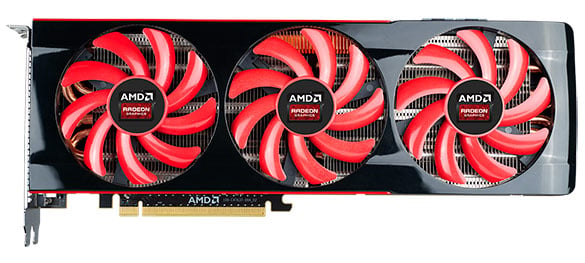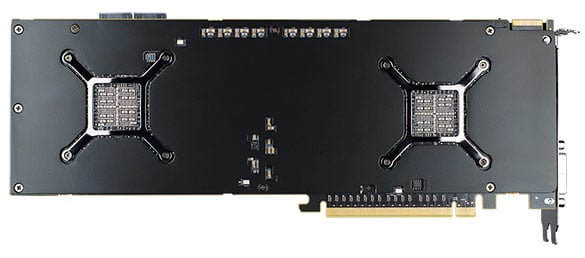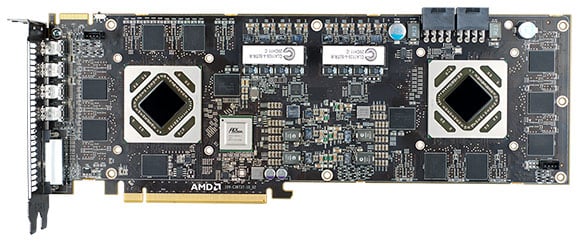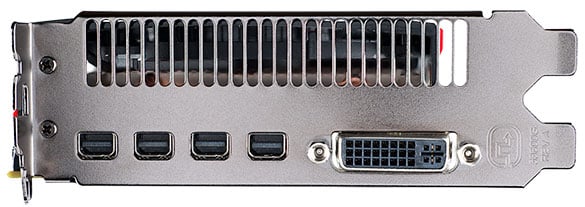AMD Radeon HD 7990 Review: The Quiet Beast
The AMD Radeon HD 7990
A quick glance at the Radeon HD 7990 reveals that this is no run-of-the-mill graphics card. Not only is the Radeon HD 7990 a beast at a full 12” in length, but it sports a newly-designed shroud, three huge cooling fans, and massive heatsink assembly with a dense array of aluminum fins.
Although it looks like there’s only one, gigantic heatsink underneath that fan shroud, there are actually two—one for each GPU. The dual heatsinks each have a copper base, linked to the aluminum thin fins via four copper heatpipes. The three axial fans on the card blow air down onto the heatsinks, where some air is expelled from the case through a vent in the font, but a majority is circulated back into the case. In fact, air is actually expelled from the card in every direction. We should mention that in addition to high-performance, the cooler on the Radeon HD 7990 is designed to be quiet as well—much quieter than previous Radeon HD 7900 series products. But we’ll touch more on that subject later.
The Radeon HD 7990 needs such a large cooling assembly because it is essentially a pair of Radeon HD 7970 GHz Editions crammed onto a single PCB, with just slightly lower GPU clocks. The two Tahiti GPUs powering the card have a peak boost clock of 1GHz (the Radeon HD 7970 GHz Edition boosts to 1050MHz) and they’re each paired to 3GBs of GDDR5 memory clocked at 1.5GHz (6 Gbps, effective), via a 256-bit memory bus, for a total of 6GB of on-board memory. The aggregate effect of having the two GPUs results in a grand total of 4096 stream processors, 256 texture units, 64 ROPs, and a combined 8.6B transistors. Compute performance peaks at 8.2 TFLOPS, with a 256 GT/s textured fillrate and a massive 576 GB/s of memory bandwidth.
The two GPUs on the card are linked together via a 48-lane PCI Express Gen 3 PLX bridge chip that offers 96GB/s of inter-GPU bandwidth.
In addition to the newly-designed cooling hardware, the Radeon HD 7990 is outfitted with a heatplate on the backside of the PCB, which also adds rigidity and the card sports an all-digital PWM. Like AMD's previous dual-GPU flagship, the Radeon HD 6990, the Radeon HD 7990 requires a pair of supplemental 8-pin PCI Express power feeds. Take all of the goodies on a Radeon HD 7970, double ‘em up, cram them only a single PCB and you’ve got a Radeon HD 7990.
The output configuration on the Radeon HD 7990 consists of four mini-DisplayPorts and a single dual-link DVI output. And, of course, the card supports AMD’s multi-display Eyefinity technology, with up to five independent displays running simultaneously. Technically, with two Tahiti GPUs, the card has the ability to output video to 12 displays (6 per GPU), but only five outputs are on the card. Perhaps on of AMD’s board partners will get a little nutty and expose more.










